A black hole is a location in space with such a strong gravitational field that the escape velocity exceeds the speed of light. What this means is that you require a velocity greater than the speed of light (a physical impossibility) to escape the black hole, as can be seen in the image below:

In General Relativity, mass warps space time depending on the mass-density, and so when you pack a lot of mass in a very small area, space time curves so severely that it traps even light. Since a black hole does not reflect—apart, potentially, from the nearly undetectable Hawking radiation—it is thus completely black.
The image below is a nice analogy for a black hole, where, beyond a certain point, the water current is so strong that no speed will be sufficient to escape it. Do note however that the image below is a two dimensional representation, whereas a black hole is three dimensional.
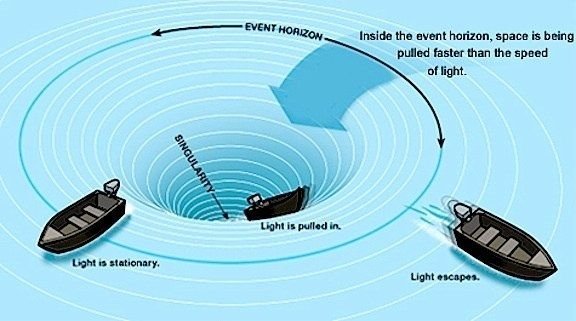
How is a black hole formed?
It all starts with a massive star. As the star fuses hydrogen into heavier elements (a process called thermonuclear fusion), the heat produced creates an outward pressure, which acts against the inward force from gravity. In essence, the thermal pressure prevents the star from collapsing under its own gravity, and as long as the star has fuel to fuse and create heat, the thermal pressure and gravity are in balance (called hydro static equilibrium).
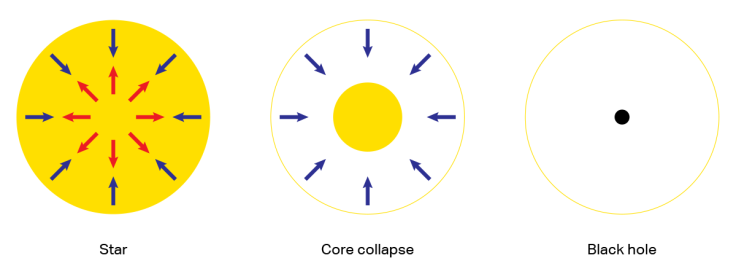
At one point the star runs out of fuel, which means the thermal pressure decreases, and gravity takes over. This is when a core collapse occurs. Stars with an end mass below the Chandrasekhar limit of 1.4 times the mass of the Sun will collapse into white dwarfs, stars with an end mass between the Chandrasekhar limit and the Tolman–Oppenheimer–Volkoff limit (TOV limit) of 2–3 times the mass of the Sun will become neutron stars, and stars with an end mass above the TOV limit will become black holes. This end mass correlates with an initial mass of at least 25 times the mass of the Sun.
Let’s say the star in the image above is 30 solar masses. When the core collapses, an explosion occurs called a supernova, which ejects a lot of the material into space. Here is an image of an actual supernova:
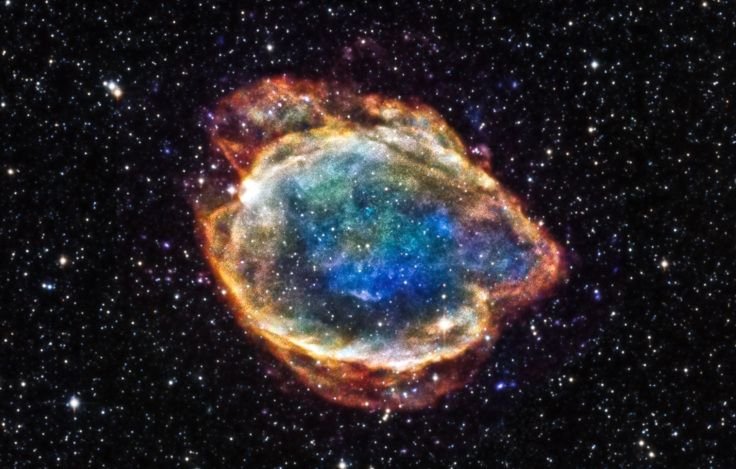
In the image below you can see how the initial mass of a star relates to its end mass. For a star with an initial mass 30 times the mass of the Sun, its end mass is around 4 solar masses—enough to form a black hole

I marked two lines in the image as examples on how to read it. A star with an initial mass of 25 M☉ (solar masses) will have an end mass of around 2 M☉ (remember the TOV limit of 2–3 M☉?). I also marked a star of 30 M☉ in blue, which as you can see corresponds to an end mass of 4 M☉. Also, as you can see any star with an initial mass below 25 M☉ will become a neutron star with a mass of 0.88–1.44 M☉.
Why does a black hole have such an intense gravitational field?
Now, here comes the crucial bit. The strength of a gravitational field depends on two factors:
- The mass of an object.
- How far away you are from the object.
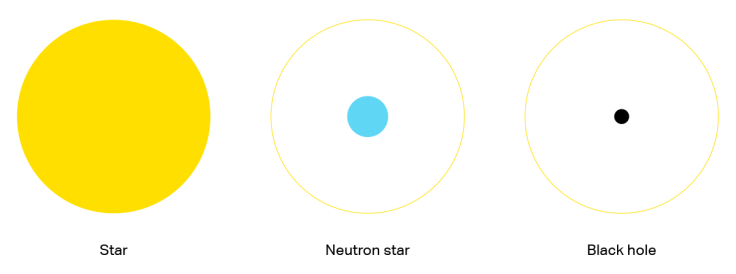
If you look at the star above, it has a much bigger radius than the neutron star and the black hole. The proportions are way off however, as the neutron star and black hole are far smaller than this. While the Sun has a diameter of 1.3914 million km (and 1 solar mass), a neutron star is typically about 20 km in diameter (at around 1.4 solar masses), and a black hole with a mass of 3 solar masses is thought to be compressed to a point, though its Schwarzschild radius (or gravitational radius) at this mass is around 8.86 km (17.73 km in diameter). I will talk more about the Schwarzschild radius in a moment.
So here you have three objects of increasing mass, but decreasing radius. Now, although all three objects have gravitational fields of different strengths due to differences in mass, their radius is also crucial. If we assume all three objects to be of the same mass but different sizes, then in order to experience the same gravitational field from the star as from the neutron star, you would have to be inside the star. However, to experience the same gravitational field from the neutron star as from the regular star, you can be a long distance away from it (indicated by the yellow circle around the neutron star). So you see, given the same mass but a smaller radius, you can get much closer to the neutron star as you could to the regular star, and so you would experience a far more intense gravitational field on the surface of the neutron star as on the regular star. A black hole has more mass and a far smaller radius (presumed to be a point source), so its gravitational field when you get close to it is really extreme. Extreme enough so that not even light—which has the greatest speed possible in the universe—can escape, as we saw at the beginning.
What is the anatomy of a black hole?
Below you can see a simplified version of the relevant parts of a black hole. First of all, we talked about how a black hole is compressed to a point. At least, this is what is supposed, though in reality we really don’t know if a black hole is actually a point source. Whether this point source is physical or mathematical, it’s called a gravitational singularity. This singularity has a region within which the escape velocity exceeds the speed of light, defined by the Schwarzschild radius. The boundary beyond which not even light can escape the black hole is called the event horizon, which is a boundary in space time.
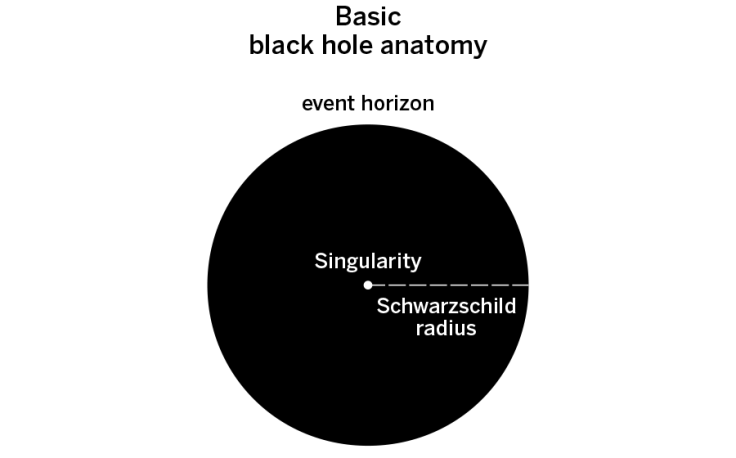
Mass curves space time, and in case of a black hole the mass density curves space time to such an extent that light becomes trapped. The image below gives some idea of what that is like, though do keep in mind that this is a two dimensional representation of the warping of space, whereas in reality space is warped three dimension ally. Therefore it’s better to think of space time curving inwards, creating a gravity well (pictured in b in the image below).
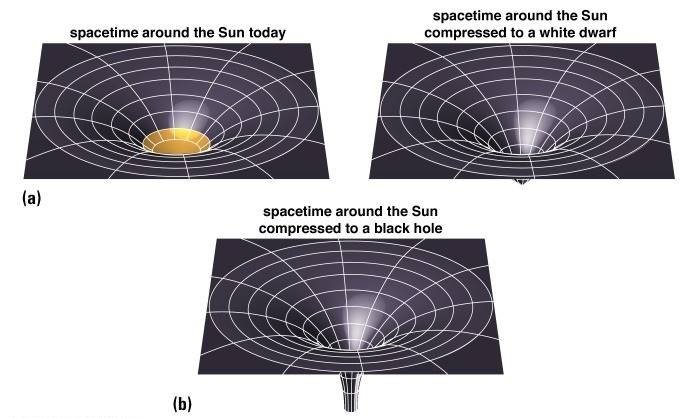
Let’s look at a more complete picture of the black hole anatomy. Below is a Schwarzschild black hole, which is the most general black hole model. It’s a non-rotating black hole without charge. No non-rotating black holes are thought to exist, but the Schwarzschild metric provides a simple model of what’s going on in a black hole. In a moment we will have a look at a rotating black hole.
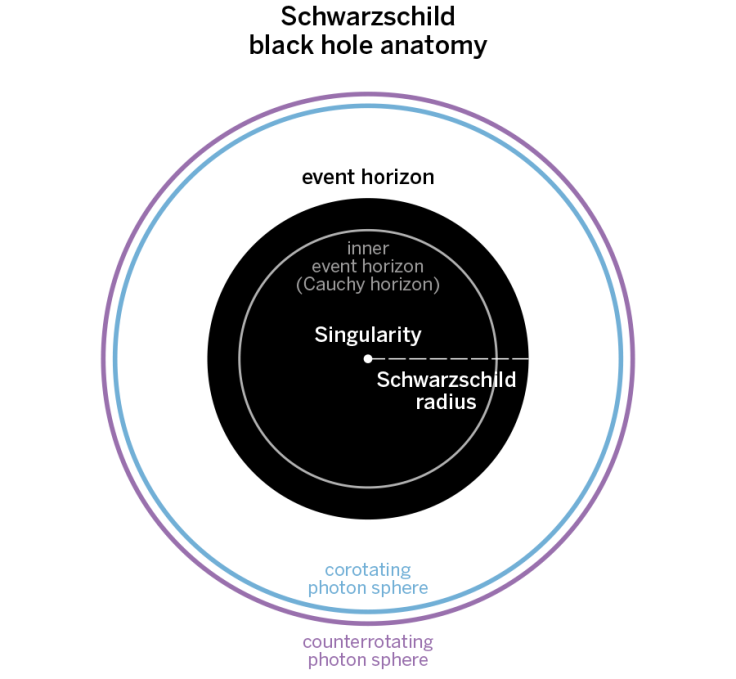
As you can see, there are two to three additional components compared to the basic black hole anatomy. A black hole has an outer event horizon, and an inner event horizon, or Cauchy horizon. One side of the Cauchy horizon contains closed space-like geodesics, and the other side contains closed time-likegeodesics. A geodesic is the shortest path between two points in a curved space. As matter falls into the black hole, it takes the shortest possible path, and beyond the Cauchy horizon space- and time geodesics become reversed. So beyond the inner event horizon, you are no longer traveling through space, but through time. As such, if you were to cross this horizon, you would move towards your inevitable future which is the singularity.
Outside the Schwarzschild radius, there is a boundary called the photon sphere, where gravity is strong enough that photons (light particles) are forced to travel in orbits. Beyond that boundary and you will move towards the event horizon, but at the photon sphere, photons will travel in orbits for at least a little while (the orbits are unstable). What’s interesting about photons orbiting in circles is that when you are located at the photon sphere, photons that start at the back of your head will orbit the black hole, and will then be captured by your eyes, so effectively you will see the back of your head. Weird stuff.
And finally, let’s have a look at a rotating black hole, which is either a Kerr black hole (a rotating black hole without electric charge) or a Kerr–Newman black hole (a rotating black hole with electric charge). A black hole can only have three fundamental properties: mass, electric charge and angular momentum (spin).
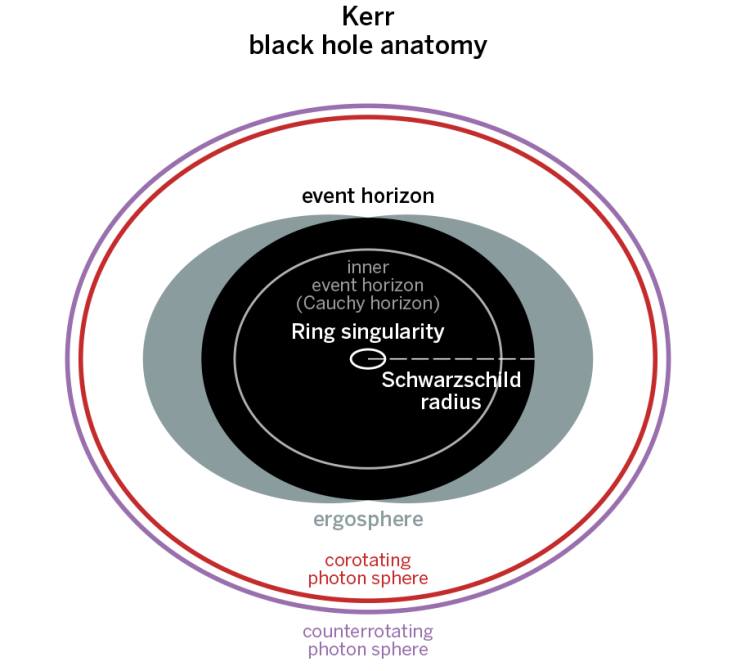
Stars rotate, and when a massive star collapses into a black hole, its angular momentum is not only conserved in the black hole, but as its radius decreases considerably, so too will its angular momentum increase. Think of an ice skater, who increases its spin rate when she pulls in her arms, which decreases her moment of inertia.

The rotation of the black hole causes the Schwarzschild radius to become oblate due to the centrifugal force. Also, the gravitational singularity is no longer a point source, but a twodimensional ring singularity. One important additional component to a rotating black hole is the ergosphere, which is a region beyond the outer event horizon. The ergosphere touches the event horizon at the poles of a rotating black hole and extends to a greater radius at the equator, and depending on the speed of rotation of the black hole, the ergosphere will be shaped either like an oblate spheroid or a pumpkin shape.
As a black hole rotates, it twists spacetime in the direction of rotation at a speed that decreases with distance from the event horizon, meaning that spacetime closer to the event horizon will be twisted to a greater degree than the space further out from the event horizon. This process is known as the frame-dragging. Because of this dragging effect, objects within the ergosphere cannot appear stationary with respect to an outside observer at a great distance unless the object was to move at faster than the speed of light with respect to the local spacetime, which is not possible. Since the ergosphere is located outside the event horizon however, objects in this region can still escape from the black hole by gaining velocity due to the rotation of the black hole.
Note- All the images are from google images
Hi! I am a robot. I just upvoted you! I found similar content that readers might be interested in:
https://www.forbes.com/sites/quora/2017/06/08/the-physics-of-black-holes-explained-for-non-scientists/